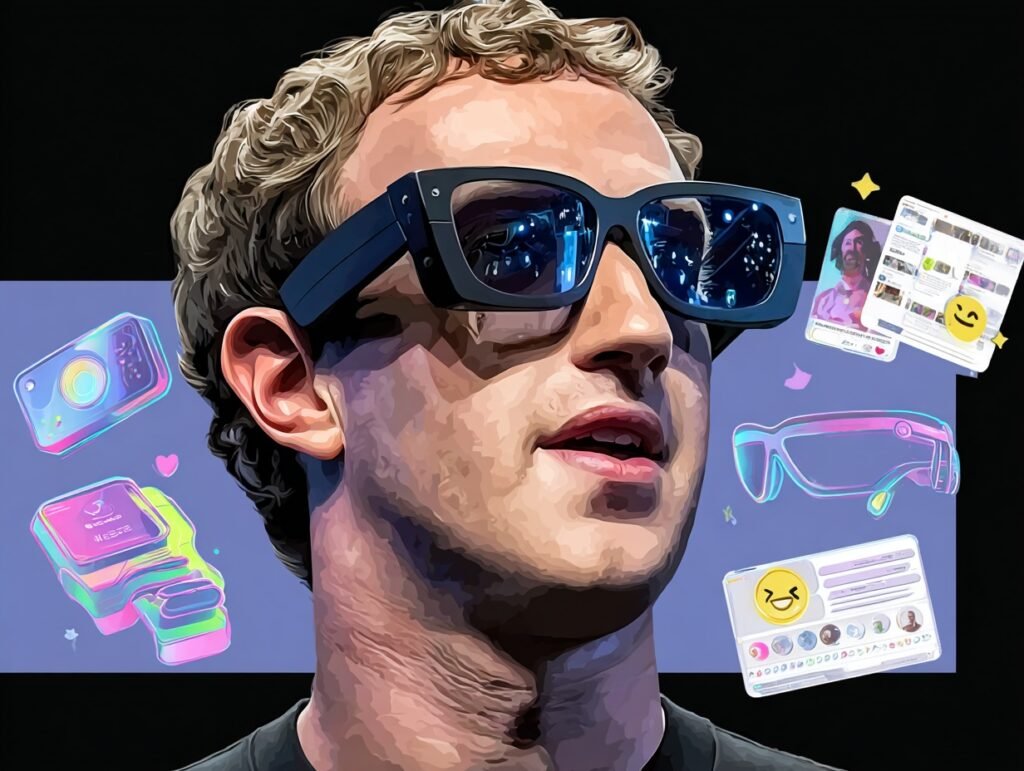
At this year’s Meta Connect 2025, Mark Zuckerberg and his team made one thing very clear: the future of personal technology isn’t another smartphone—it’s sitting on your face. The show was dominated not by VR headsets, but by sleek, AI-driven eyewear and a small wristband that could quietly redefine how we interact with machines.
The Star of the Show: Ray-Ban Meta Display
The highlight was undeniably the Ray-Ban Meta Display glasses, nicknamed “Hypernova.” On the surface, they look like regular Ray-Bans. But embedded in one lens is a waveguide display capable of flashing maps, texts, translations, and live notifications into your field of vision.
The real magic is the accompanying Meta Neural Band, a slim wrist strap that reads your muscle signals (sEMG). Instead of awkward head-nods or voice commands, you can swipe your thumb against your index finger to scroll a menu, pinch to zoom, or even type midair on a virtual keyboard. I tried imagining myself grocery shopping with these—pulling up my list with a pinch and swiping through items like beans and oat milk invisibly. It’s a subtle shift that could make glasses, not phones, our next default interface.
Oakley Joins the Field Game
Meta also doubled down on its partnership with Oakley, introducing the Meta Vanguard sport glasses. These are made for runners, cyclists, and skiers—complete with a wider camera field of view and integration with Garmin and Strava for real-time health and performance overlays. Think of them less as a gadget and more as GoPro meets Fitbit for your face.
An Expanding Ecosystem: Horizon Studio, Hyperspace, and Horizon TV
The glasses weren’t alone. Meta used the event to roll out a new software suite:
- Horizon Studio — lets creators generate 3D immersive worlds using text prompts. AI builds the characters, sounds, and scenery.
- Hyperspace — scans your room through a Quest 3 and builds a photorealistic 3D replica in minutes. At the demo, we saw Chance the Rapper’s living room and Gordon Ramsay’s kitchen turned into explorable spaces.
- Horizon TV — bundles Disney+, Blumhouse horror movies, and more into a VR-ready streaming platform. Imagine watching M3GAN with effects that spill into your virtual living room.
It was a reminder: Meta doesn’t just want to sell glasses—it wants to make sure there are reasons to wear them.
A Few Glitches (Literally)
Of course, no Meta keynote would be complete without awkward demo fails. Zuckerberg attempted to make a WhatsApp call on the new Ray-Ban Display, but the Wi-Fi gave out. In years past, he might have crumbled under the silence; this time, he pivoted quickly, carrying on with calm confidence. A small indication that Zuckerberg himself—just like his glasses—has become more comfortable in public.
Why This Matters
The meta-narrative (pun intended) is bigger than product launches. These glasses—and especially the Neural Band—suggest a future where interfaces disappear into our bodies. No more fumbling for phones. No clumsy VR headsets. Instead, AI becomes ambient, contextual, and wearable.
But there’s risk: making this technology socially acceptable. Glasses are fashion first, gadget second. If Meta’s frames feel too clunky, no amount of AI wizardry will matter. Look back at Google Glass—what failed wasn’t the tech, it was the social stigma. The challenge for Zuckerberg’s vision of “personal superintelligence” isn’t just making the glasses smart; it’s making them something people actually want to be seen wearing.
